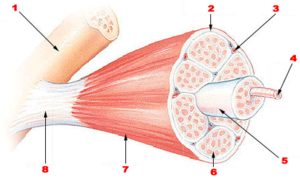Most people know that living organisms increase in size through cell division. Cell division is a term referred to how cells in the body are constantly involved in a series of replication and divisions of the existing cells to make new cells because cells, like organisms, do not live forever. The old cells are replaced by new cells through continuing processes of mitosis and meiosis.
But, it is crucial to understand that not all cells divide and increase in numbers. The abs that Gerard Butler showed off to women in the film 300 or the toned muscles that Taylor Lautner used to woo teenagers in New Moon did not come because their muscle cells increased from the cell divisions.
Then, how do the muscles change if they do not divide?
Before answering that question directly, let us explore a bit about muscles first. Muscle cells are examples of cells that are in the phase called G0 state, a nondividing phase in cell division. When muscles cells reach the level of maturity, they no longer divide and just perform the functions in the developmental stages up to that point.
Gerald Karp, the author of Cell and Molecular Biology: Concepts and Experiments, explained this phenomenon:
Cells, such as nerve cells, muscle cells, or red blood cells, that are highly specialized and lack the ability to divide. Once these cells have differentiated, they remain in that state until they die.”1
Now, to answer the question, the changes in muscles originate in the fibers. Muscles have intricate structures from fibers, which I will not cover in details here (but if you choose to, feel free to check out this page from Wikipedia, or even better, a textbook). It is the change in the fibers of muscles that cause noticeable differences in muscles and its subsequent effects.
For instance, in terms of skeletal muscles, there are two types of fibers: red fibers and white fibers. Red fibers contain more myoglobins, or oxygen-binding proteins similar to hemoglobins in your lungs, and therefore, are suitable for long-term and aerobic exercises. On the other hand, white fiber have less myoglobins and can fatigue easily. Now that you know these muscle fibers, which one of two muscle fibers would fast, short-distance runners will have more?
But, one question still remains. As in any concept in science, there is rarely such a thing as “never.” So, will muscle cells destined to exist in G0 state and never divide, or can there be an exception?
In 2005, Howard Hughes Medical Institute (HHMI) researchers conducted an experiment to find more about this with heart muscle cells in adult animals. Their research surrounded an enzyme called p38, which has been known to regulate the cell divisions. They did find a significant change in proliferation by controlling p38, but they tested their ideas on rates, not humans, in vitro, as opposed to in vivo, so it was not completely clear whether p38 was the deciding factor.2
Mark T. Keating, the HHMI investigator at Children’s Hospital Boston and Harvard Medical School who led this research, gave his thoughts on this study on HHMI news.
“We still do not know the molecular mechanism of the effect that we have observed. And we don’t understand other possible mechanisms that regulate cardiomycyte proliferation. In this study, we don’t mean to imply that we think p38 is the only pathway that is important in regulating proliferation. We think there are likely to be others as well.”
The beauty of science, however, always involves on the processes, not just the results, so perhaps, we will see new news on muscles and cell divisions that may provide some clinical insights to existing medical problems.
1 Gerald Karp, Cell and Molecular Biology: Concepts and Experiments, 4th Edition (New Jersey: John Wiley & Sons, Inc., 2005) 580.
2 Howard Hughes Medical Institute, “HHMI News: Researchers Spur Growth of Adult Heart Muscle Cells,” May 3, 2005. Accessed March 21, 2010.



